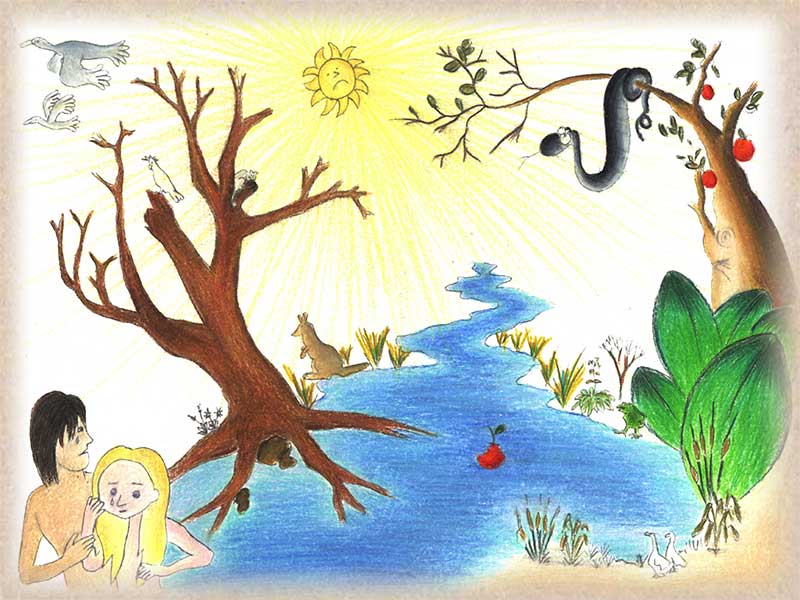
Indigenous
Who are the World's Indigenous People > Aboriginal Culture > Aboriginal Art and the DreamingTwo Laws, One Land > Sorry, We have Ruined our World
Who are the World's Indigenous People?
Many of the world's staple foods, such as peppers, potatoes, lentils, peas, sugar cane, garlic and tomatoes, were first cultivated by indigenous peoples. From the various indigenous languages of the Americas come familiar words like canoe, barbecue, squash, powwow and moccasin. An estimated 75 per cent of the world's plant-based pharmaceuticals, including aspirin, digitalis and quinine, have been derived from medicinal plants found in areas occupied by indigenous people. Indeed, the contribution of indigenous peoples to modern civilization is pervasive.
Indigenous peoples inhabit large areas of the earth's surface. Spread across the world from the Artic to the South Pacific, they number, at a rough estimate, some 300 million.
Indigenous or aboriginal peoples are so called because they were living on their lands before settlers came from elsewhere; they are the descendants -
according to one definition - of those who inhabited a country or geographic region at the time when peoples of different cultures or ethnic origins arrived.
The new arrivals later became dominant through conquest, occupation, settlement or other means.
Indigenous peoples are descendants of the original inhabitants of many lands, strikingly varied cultures, religions and patterns of social and economic organization.
At least 5,000 indigenous groups can be distinguished by linguistic and cultural differences and by geographical separation.
Some are hunters and gathers, while others live in cities and participate fully in the culture of their national society.
But all indigenous people retain a strong sense of their distinct cultures, the most salient feature of which is a special relationship to the land.
How many indigenous people are there, and where do they live?
The world's estimated 300 million indigenous people are spread across the world in more than 70 countries. Among them are the Indians of the Americas, the Inuit and the Aleutions of the circumpolar region, the Sami of norhtern Europe, the Aborigines and the Torres Strait Islanders of Australia and the Maori of New Zealand. More than 60 per cent of Bolivia's population is indigenous, and indigenous peoples make up roughly half the populations of Guatemala and Peru. China and India together have more than 150 million indigenous people. About 10 million indigenous people live in Myanmar.What are the living conditions of indigenous people?
- Most of India's tribal people live below the poverty line.
- The life expectancy of indigenous people in northern Russia is 18 years less than the national average.
- Unemployment among Australia's Aboriginal people is five times the national average.
What are the concerns of indigenous peoples?
Among the issues that concern indigenous people are: land and resources, human rights, internal colonization, self-government, self-development, environment, discrimination, health, education, language, cultural survival, intellectual property rights & social and economic conditions...With crisis such as global warming, deforestation, desertification and depletion of the ozone layer surging to the top of the international agenda, indigenous people find themselves in an ironic position. Once dismissed as too "primitive" to cope with modernization, and for centuries the victims of discrimination, land seizures and worse, indigenous people have begun to be recognized for their prowess at environmental management, and acknowledged as key players in the global effort to chart a more hopeful course of development for the future of humanity.
Victims of environmental degradation
An enormous gap remains, however, between the goals set forth in Rio and the plight of indigenous peoples. In the last 40 years, indigenous lands have come under relentless pressure as Governments, development banks, national and transnational corporations and entrepreneurs search for resources to meet the growing demands of high-consumption industrialized societies and the needs of fast swelling populations in developing countries. Once largely inaccessible, these regions and their mineral deposits, hydro-electric potential, hardwoods, oil and new farm and pasture lands have been put within reach by modern technology. The long tenure of indigenous peoples upon their lands has proved to be little protection.In Canada, one million indigenous people have increased their visibility and attained a level of political power previously unimagined. Mohawks, Cree Inuit and other native Canadian communities have used their newfound position to protect their lands and carve out new social and economic gains
In a landmark decision, the High Court of Australia declared in 1992 that the traditional land rights of the Murray Island people in the Torrens Straits had not been extinguished by the arrival of the British in Australia. Since the very basis of European occupation of Australia since 1788 has been the doctrine of "terra
Indigenous people in many parts of the world have made important gains in recent years in their long standing drive to achieve autonomy in their ancestral home lands. On the other hand, the reluctance of many Governments to grant further recognition to the claims of indigenous poples to self-rule has impeded progress in this area for a vast number of indigenous communities.
What is the purpose of the International Year?
The year was requested by indigenous organisations and is the result of their efforts to secure their cultural integrity and status into the twenty-first century. It aims above all to encourage a new relationship between States and indigenous peoples - a new partnership based on mutual respect and understanding.

